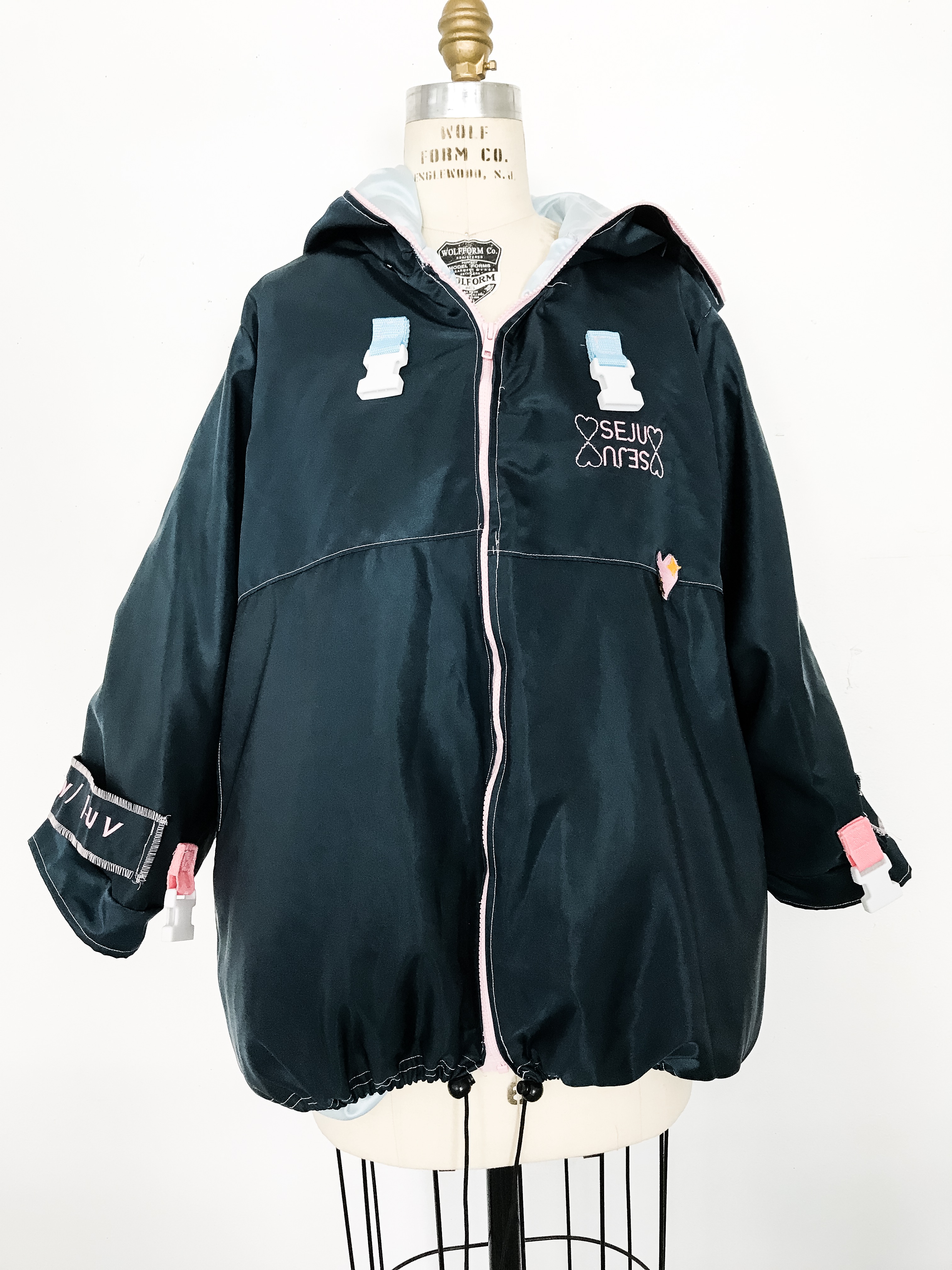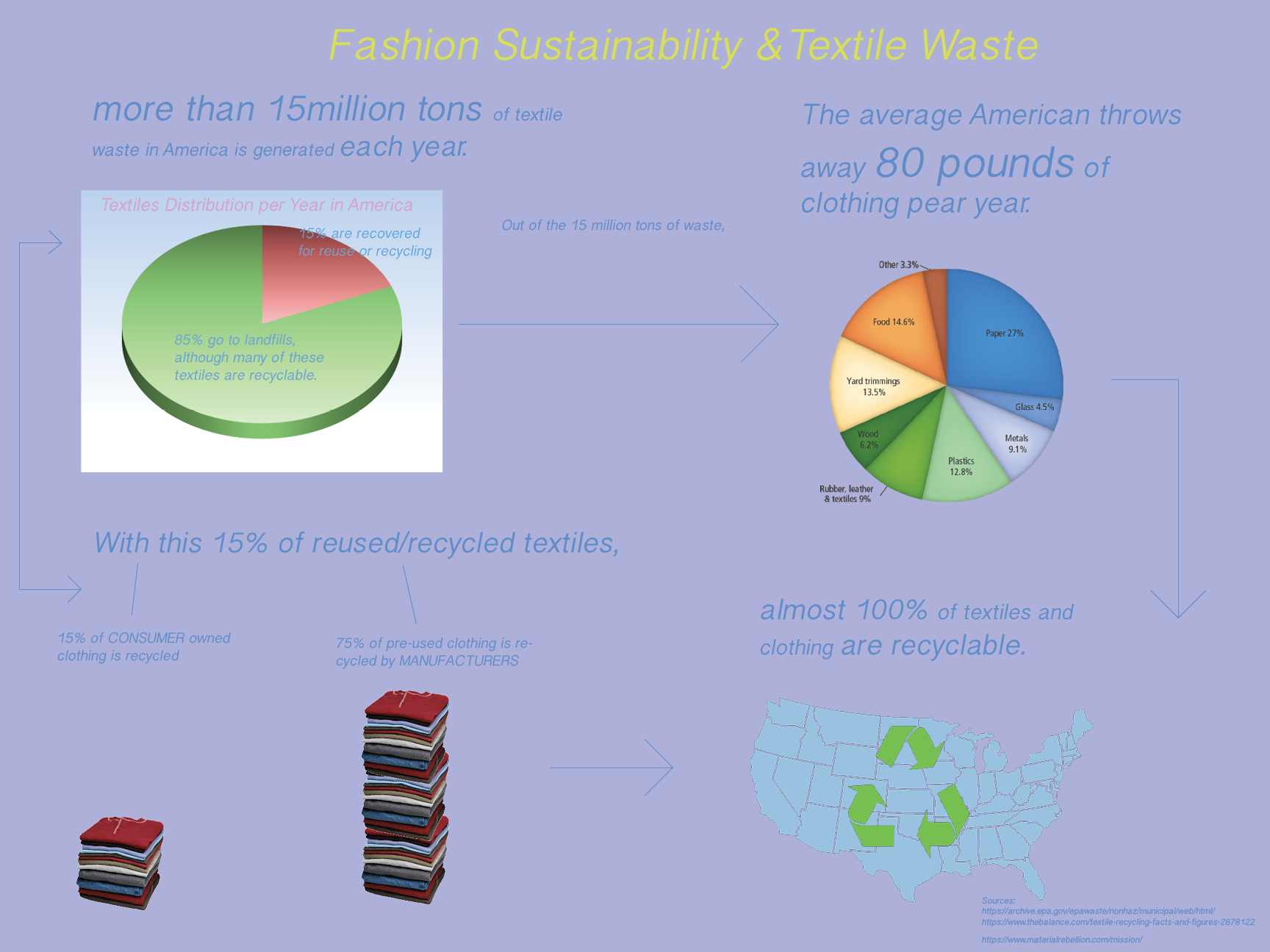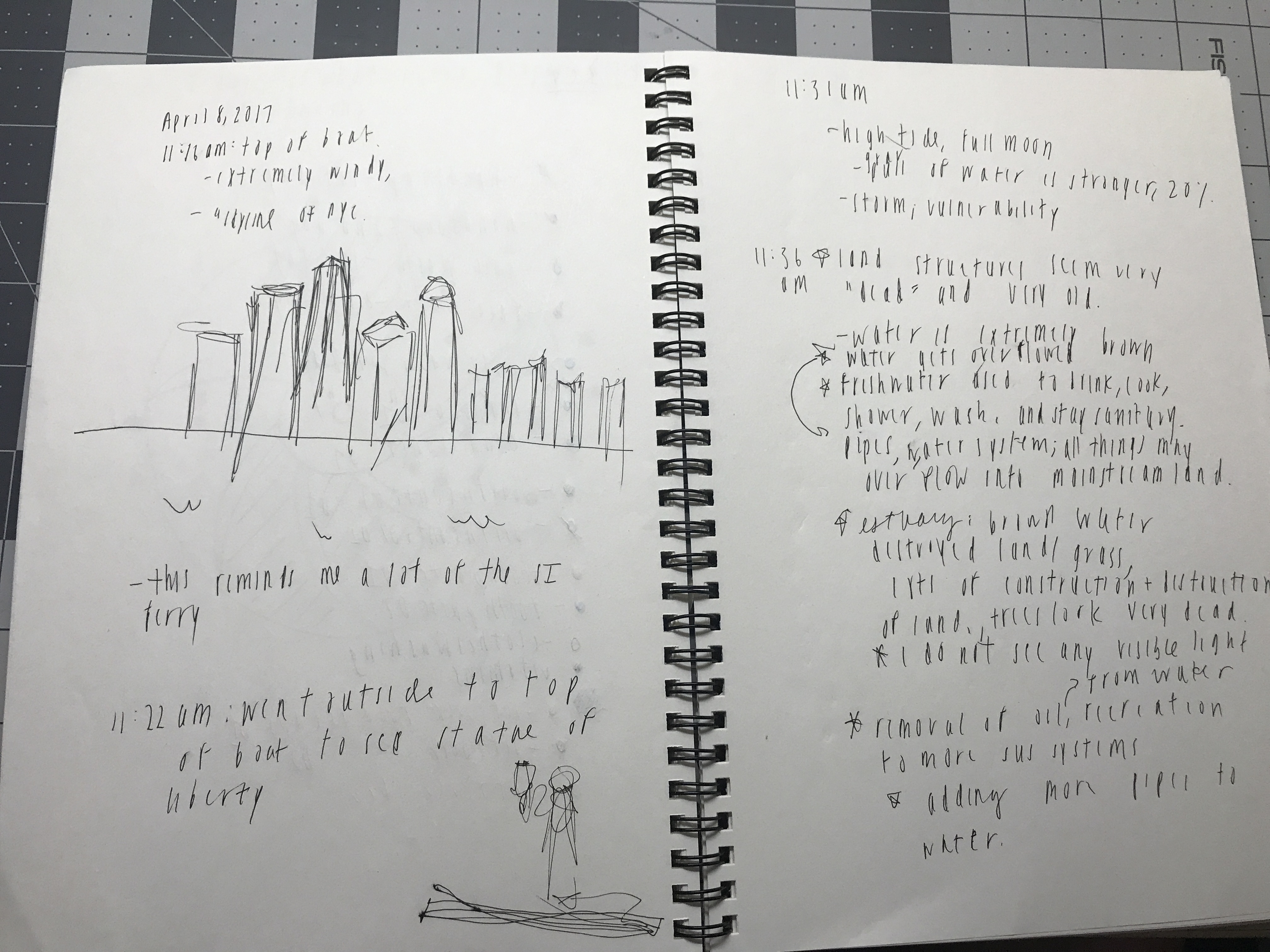1. YI/YI project: project statement
Fast fashion is one of the key movements in fashion that has led to a large use of environmental resources as well as degradation to the planet. This market “concept”-based model was developed around the 1980s and 1990s and also during the first part of the 21st century. It can also be considered disposable fashion, because it provides wearable, designed products at such a low price.
To counteract fast fashion, sustainable/slow fashion started to appear publicly in America during the late 1980s and early 1990s. However, fast fashion started around the Industrial Revolution time period. During the Industrial Revolution, different kinds of machines were invented, that speeded up the process of fashion production. Prices of clothes went down as production of clothes increased, making it more affordable for everyone. Patented in 1846, the sewing machine and its factories became the source of mass production of clothing.
Fast fashion benefits but also hurts people in the process, globally. It would usually benefit people in developed countries, and take many consequences for those who live in developing,underdeveloped, and third world countries. Fast fashion usually targets areas in the world where production would be cheapest; otherwise called outsourcing. This further makes mass production even more affordable to the owner, since they would spend less and profit more, which leads to more people working under poor conditions in sweatshops, as well as producing a lot more pollution and releasing carbon dioxide into the atmosphere.
Along with the mass production of clothing, fast fashion clothing is manufactured using synthetic, inorganic materials, using chemical and energy heavy processes and methods, which uses large amounts of oil. Toxic dyes are also used, that can wash off with rain and find their way into other water resources. A lot of the wasted clothing that comes from fast fashion is dumped into landfills and pollutes the ground and water, during the process and after the process of making an article of clothing. After this clothing is made, it is then transported by trucks, cars, airplanes, which contribute to the burning of fossil fuels and the release of CO2 in the atmosphere.
I first started to take note and become interested in the topic of sustainable fashion around the beginning of my senior year in high school. This is the year I took my AP environmental science course. Although I was generally aware of fast fashion and mainstream ideas of environmental pollution, I never came to an understanding of how detrimental it was to the earth and the environment. As someone who used to love to shop at H&M and Forever 21, I always liked the idea of “quantity over quality” with fashion and clothing. I’d buy many things that weren’t even my size, so I could convince myself to lose weight so I could fit into these clothes. However, all these clothes are just stored in a box or in a suitcase, never to be opened. After a very short period of time, the trend of these clothes were already gone. I slowly became more interested and invested in branded and quality clothing, but I am still guilty of shopping at places like Uniqlo, that are also considered fast fashion. I’ve also become more aware of how well tailored and made high-end clothing was made, which made me more attracted to clothing that had higher quality, although expensive. In America, I feel that fast-fashion made clothing has very cheap quality, in comparison to places like Korea, which sell clothing cheaper than fast-fashion retail stores like H&M and Zara, for a better quality. During my time of travel, I’ve noticed that in places like Korea, Japan, Taiwan, and Vietnam, street-clothing tends to have better quality fabrics that sell for very cheap prices, almost as if they weren’t profiting from the clothes made. I have become a victim of what will profit me the most in the end – cheaply made clothing of high quality, and also branded clothing.
A few solutions to a more-sustainable fashion planet would be to have a recycling bin for clothing, instead of putting them with plastic or with actual compost. They should be categorized into different types of fabrics or apparel: coats, denim, pants, skirts, tops, or cotton, wool, acrylic, etc. They should be easily accessible or be a part of every homes trash/recycling bins. Another option would be to have a suitcase or tote bag that can be organized into different types of clothing, that can be sent nearby to a recycling clothing bin or store. By having recycle bins or bags that are accessible to everyone, I believe less clothing would be thrown away, and would promote recycling/upcycling of clothing. Organizing plastic became a habit I had to grow into while living in Korea for a short period of time, and I believe it can be a habit to recycle clothing too.
After long thoughts of deciding what to do for my YI/YI project, I switched from making a recyclable bag to making a recycling bin to making a garment. I concluded with making a jacket that could be convertible into a backpack. Since textile waste was one of the main issues affecting levels of toxins in air and on land, I wanted to make this garment as zero-waste as possible. I felt that having a convertible item that had multi function would be more efficient in the use of materials rather than having a separate bag and a separate jacket. However, I wanted this to also be waterproof, so it does not wear down as easily. Nylon, although a synthetic fabric, is durable around rain, and will last long as a jacket/backpack product. It can last for years. Essentially, making a garment that will last longer and live through the years would eventually lower the water and carbon footprint of the earth.
A few facts about the production of garments/accessories as well as unsustainable fashion:
- Tanning is a process of treating skins and hides of animals to produce leather. This started in India around 7000 and and 3300 B.C. Animal skins were usually used for waterskins, bags, harnesses and tack, boats, armour, quivers, scabbards, boots, and sandals. It is done all over the world in factories, requiring a huge amount of energy, resulting in large amounts of waste. Tannery effluent contains huge amounts of pollutants, which include chemicals that stop the collagen from biodegrading. People who also work in tannies suffer as well, as many die from cancer due to exposure from hazardous chemicals. It is important to decrease the use of leather or use other alternatives as livestock pollution is one of the greatest threats to our waterways.
- Cotton, mostly grown for fashion, uses 22.5% of the world’s insecticides and 10% of all pesticides. It is also a cheaper and most traditional way to make fabric, and then eventually clothes, affordable for many people. Majority of the pesticides used have harmful toxins and cancer causing carcinogens. Water in surrounding areas of cotton farms are also affected, as it becomes too toxic for people to drink from; affecting millions of people as well as 25-77 million million agricultural workers who suffer from acute pesticide poisoning. Although organic cotton is an alternative option, it would make the prices of clothes increase, as well as become inefficient in terms of production of clothing.
- Synthetic dyes are used in fashion production, resulting in around 20% of water pollution worldwide. There are also many that are toxic, leaving textiles to have one of the largest footprints on the planet.There is an option of waterless dying, but it is probably not going to occur mostly because it lies in technology and mechanization of a factory. Different fabrics require different manufacturing processes.
- In 1950, 98% of clothing that Americans owned were made in America. Now, currently, many of these clothing factories are outsourced from other countries, making american-made clothing rare. It also deflated the price of clothes, making it super affordable. This led to huge amounts of waste and high demands, increasing in fabric waste and pollution in production and disposing of clothing.
- Fast fashion is affordable to many, and is a fast-changing trend for a global, if not worldly population. Companies like H&M has worked with heavily polluted waterways in China with dyes and other chemical runoff. Slow fashion, on the other hand, isn’t as affordable. High demands need to be met for the general or “average” American, which then further puts more clothes into production for the market to keep running.
- Packaging becomes an unnoticed part in the fashion industry. From Shipping clothes from airplane, to boat, to car or truck, and leaving them in new plastic packaging, this shows an image of what a brand wants to be selling: new clothes. Most, if not all of the plastic that comes from fashion/clothing packaging ends up in wastes.
- In the era of hypercapitalism, it is difficult to fight for workers rights. When outsourcing for the production of textiles and clothing, many workers do not have labor rights and get paid a non-living wage under very unhealthy conditions. By spending significantly less and acting upon workers rights, this will help the both the environment and affected peoples in sweatshops and factories.
- The use of animal furs, is highly abused in the fashion industry. By exploiting animals and environments, many ecosystems and environments are destroyed. Animal fur becomes a status for people who own it; due to its delicacy in incorporating it into the fabric, and because it came from a live organism. Many people know the difference between faux fur and real fur, and the costs between them are very different.
- Awareness and education relating to clothing disposal is not very well known in the United States. In fact, many people tend to ignore the fact that there are options such as donation bins or thrift shops to recycle/upcycle the use of clothes. However, some people don’t have access, are unaware, or simply just lazy because of the distance and effort it takes to continue and make this process become a habit.
Sources Cited:
Dietz, David. “Fashion Faux Pas: How is The World’s 2nd Dirtiest Industry not a Topic at Climate Week?” The Huffington Post. TheHuffingtonPost.com, 23 Sept. 2016. Web. 02 Mar. 2017.
“Environmental Hazards of Leather.” PETA. N.p., n.d. Web. 02 Mar. 2017.
Kaye, Leon. “Clothing to dye for: the textile sector must confront water risks.” The Guardian. Guardian News and Media, 12 Aug. 2013. Web. 02 Mar. 2017.
Singer, Maya. “The Clothing Insurrection: It’s Time to Take On the Fashion Supply Chain.” Vogue. Vogue, 01 Feb. 2017. Web. 02 Mar. 2017.
Process Photos:
Final Object:
Booklet including details on how to convert and wear the garment, as well as other facts:
AliceKim_YIYI-infofinal Booklet FINAL-1shtsxr
2. Field notebook/ Parsonia: Earlier entries for Union Square
3. Field notebook/ LIMBr: “Dear-Data” entries about water or plastic.
Circle Line:


























Alice, this is an awesome LP entry for this class. It is so powerful to see your research and your final product design, and your field notebook assignments altogether– it makes a high quality statement of purpose with a lot of joy as well. I hope that you are very proud! Thank you for being in our class, ML